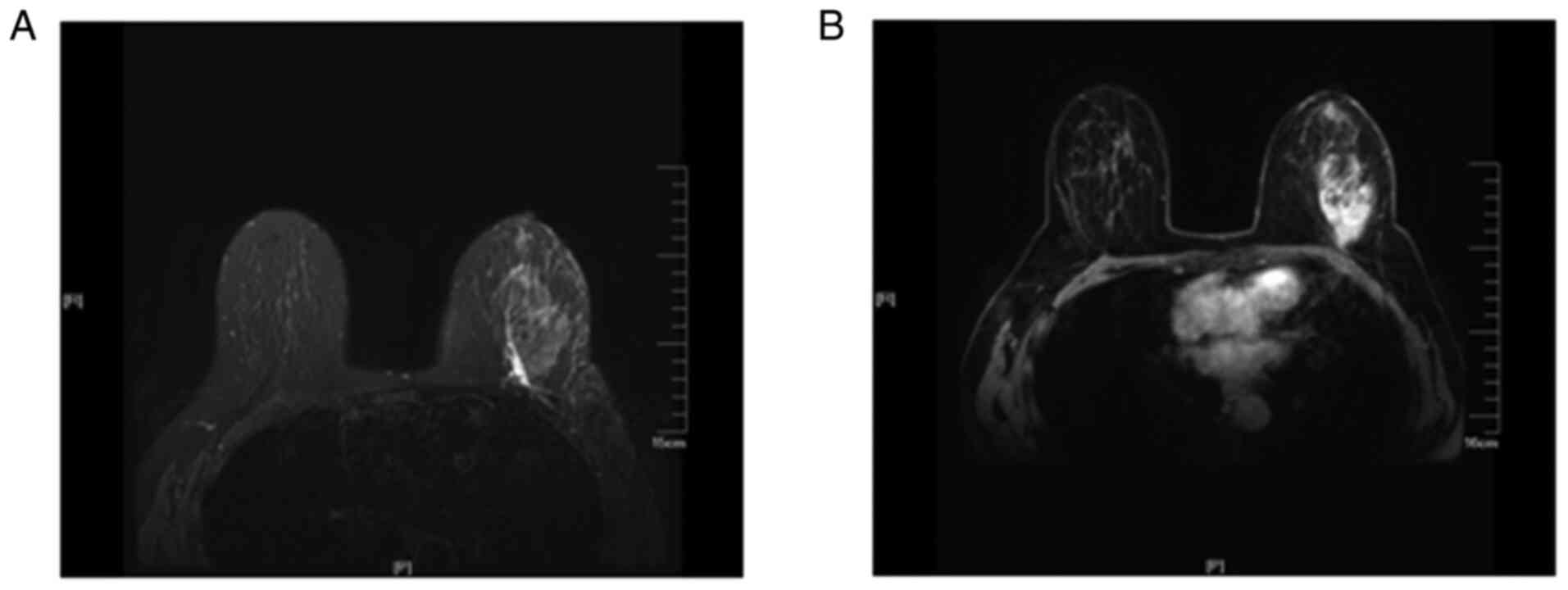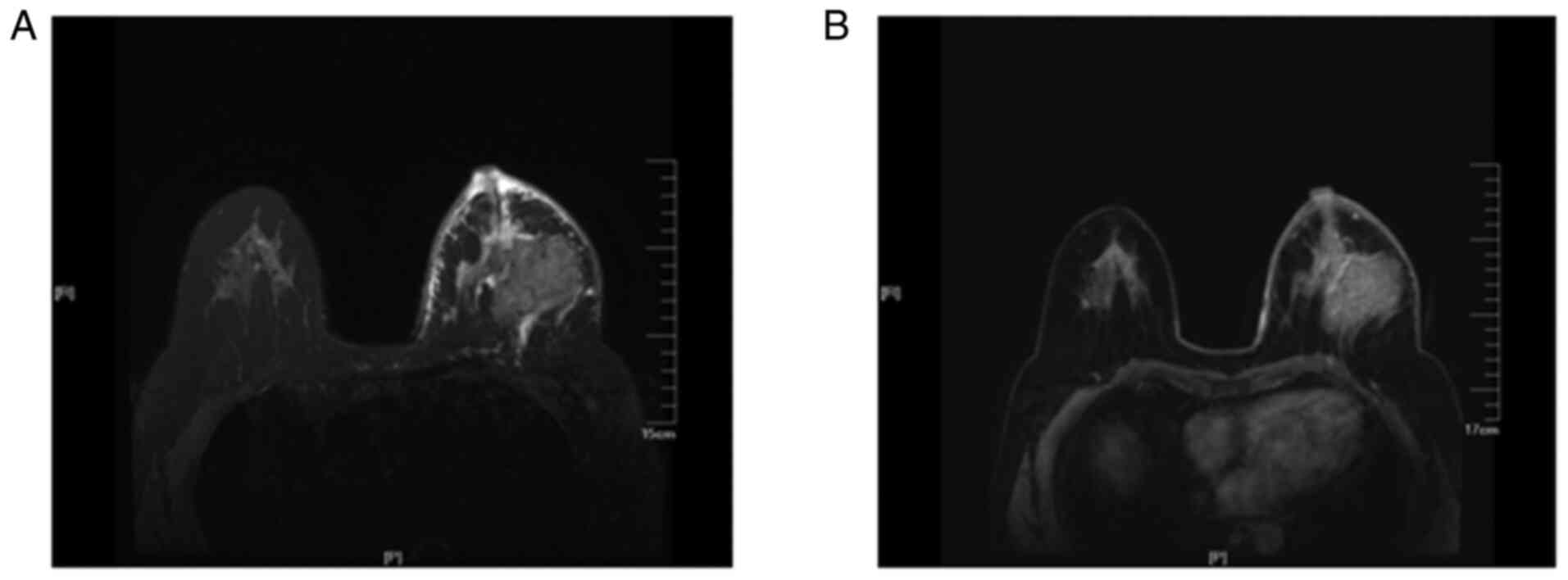|
1
|
Kuhl CK: MRI of breast tumors. Eur Radiol.
10:46–58. 2000. View Article : Google Scholar : PubMed/NCBI
|
|
2
|
Huang W, Fisher PR, Dulaimy K, Tudoria LA,
O'Hea B and Button TM: Detection of breast malignancy: Diagnostic
MR protocol for improved specificity. Radiology. 232:585–591. 2004.
View Article : Google Scholar : PubMed/NCBI
|
|
3
|
Belli P, Costantini M, Bufi E, Magistrelli
A, La Torre G and Bonomo L: Diffusion-weighted imaging in breast
lesion evaluation. Radiol Med. 115:51–69. 2010.(In English and
Italian). View Article : Google Scholar : PubMed/NCBI
|
|
4
|
Peter NH, Rinkes IH, Zuithoff NP, Mali WP,
Moons KG and Peeters PH: Meta-Analysis of MR imaging in the
diagnosis of breast lesions. Radiology. 246:116–124. 2008.
View Article : Google Scholar : PubMed/NCBI
|
|
5
|
Moschetta M, Telegrafo M, Rella L,
Capolongo A, Ianora AA and Angelelli G: MR evaluation of breast
lesions obtained by diffusion-weighted imaging with background body
signal suppression(DWIBS) and correlations with histological
findings. Magn Reson Imaging. 32:605–609. 2014. View Article : Google Scholar : PubMed/NCBI
|
|
6
|
Kul S, Cansu A, Alhan E, Dinc H, Gunes G
and Reis A: Contribution of diffusion-weighted imaging to dynamic
contrast-enhanced MRI in the characterization of breast tumors. AJR
AM J Roentgenol. 196:210–217. 2011. View Article : Google Scholar : PubMed/NCBI
|
|
7
|
Guo Y, Tang WJ, Kong QC, Liang YY, Han XR,
Zheng BJ, Sun L, Wei XH, Jin Z and Liu CL: Can whole-tumor apparent
diffusion coefficient histogram analysis be helpful to evaluate
breast phyllode tumor grades? Eur J Radiol. 114:25–31. 2019.
View Article : Google Scholar : PubMed/NCBI
|
|
8
|
Westra C, Dialani V, Mehta TS and
Eisenberg RL: Using T2-weighted sequences to more accurately
characterize breast masses seen on MRI. AJR Am J Roentgenol.
202:W183–W190. 2014. View Article : Google Scholar : PubMed/NCBI
|
|
9
|
Hammond ME, Hayes DF, Dowsett M, Allred
DC, Hagerty KL, Badve S, Fitzgibbons PL, Francis G, Goldstein NS,
Hayes M, et al: American society of clinical oncology/college of
American pathologists guideline recommendations for
immunohistochemical testing of estrogen and progesterone receptors
in breast cancer. J Clin Oncol. 28:2784–2795. 2010. View Article : Google Scholar : PubMed/NCBI
|
|
10
|
Wolff AC, Hammond ME, Schwartz JN, Hagerty
KL, Allred DC, Cote RJ, Dowsett M, Fitzgibbons PL, Hanna WM, Langer
A, et al: American Society of clinical oncology/college of American
pathologists guideline recommendations for human epidermal growth
factor receptor 2 testing in breast cancer. Arch Pathol Lab Med.
131:18–43. 2007.PubMed/NCBI
|
|
11
|
Martincich L, Faivre-Pierret M, Zechmann
CM, Corcione S, van den Bosch HC, Peng WJ, Petrillo A, Siegmann KC,
Heverhagen JT, Panizza P, et al: Multicenter, double-blind,
randomized, intraindividual crossover comparison of gadobenate
dimeglumine and gadopentetate dimeglumine for Breast MR imaging
(DETECT Trial). Radiology. 258:396–408. 2011. View Article : Google Scholar : PubMed/NCBI
|
|
12
|
Jain M, Jain A, Hyzy MD and Werth G: FAST
MRI breast screening revisited. J Med Imaging Radiat Oncol.
61:24–28. 2017. View Article : Google Scholar : PubMed/NCBI
|
|
13
|
Mango VL, Morris EA, Dershaw DD, Abramson
A, Fry C, Moskowitz CS, Hughes M, Kaplan J and Jochelson MS:
Abbreviated protocol for breast MRI: Are multiple sequences needed
for cancer detection? Eur J Radiol. 84:65–70. 2015. View Article : Google Scholar : PubMed/NCBI
|
|
14
|
Heacock L, Melsaether AN, Heller SL, Gao
Y, Pysarenko KM, Babb JS, Kim SG and Moy L: Evaluation of a known
breast cancer using an abbreviated breast MRI protocol: Correlation
of imaging characteristics and pathology with lesion detection and
conspicuity. Eur J Radiol. 85:815–823. 2016. View Article : Google Scholar : PubMed/NCBI
|
|
15
|
Uematsu T: Focal breast edema associated
with malignancy on T2-weighted images of breast MRI: Peritumoral
edema, prepectoral edema, and subcutaneous edema. Breast Cancer.
22:66–70. 2015. View Article : Google Scholar : PubMed/NCBI
|
|
16
|
Kwak JY, Kim EK, Chung SY, You JK, Oh KK,
Lee YH, Kwon TH and Jung HK: Unilateral breast edema: Spectrum of
etiologies and imaging appearances. Yonsei Med J. 46:1–7. 2005.
View Article : Google Scholar : PubMed/NCBI
|
|
17
|
Tekbas G, Oguzkurt L, Gurel K, Ozkan U,
Gur S and Onder H: Is unilateral breast enlargement always a sign
of cancer? Hemodial Int. 15:553–538. 2011. View Article : Google Scholar : PubMed/NCBI
|
|
18
|
Bakırköy Tıp Dergisi: Radiologic findings
of breast edema and causes of unilateral edema. Med J Bakirköy.
1:1–6. 2006.
|
|
19
|
Baltzer PA, Yang F, Dietzel M, Herzog A,
Simon A, Vag T, Gajda M, Camara O and Kaiser WA: Sensitivity and
specificity of unilateral edema on T2w-TSE sequences in
MR-mammography considering 974 histologically verified lesions.
Breast J. 16:233–239. 2010. View Article : Google Scholar : PubMed/NCBI
|
|
20
|
Cheon H, Kim HJ, Kim TH, Ryeom HK, Lee J,
Kim GC, Yuk JS and Kim WH: Invasive breast cancer: Prognostic value
of peritumoral edema identified at preoperative MR imaging.
Radiology. 287:68–75. 2018. View Article : Google Scholar : PubMed/NCBI
|
|
21
|
Kuhl CK, Klaschik S, Mielcarek P, Gieseke
J, Wardelmann E and Schild HH: Do T2 weighted pulse sequences help
with the differential diagnosis of enhancing lesions in dynamic
breast MRI? J Magn Reson Imaging. 9:187–196. 1999. View Article : Google Scholar : PubMed/NCBI
|
|
22
|
Simon SD, Bines J, Werutsky G, Nunes JS,
Pacheco FC, Segalla JG, Gomes AJ, Van Eyll MH, Gimenes DL, Crocamo
S, et al: Characteristics and prognosis of stage I–III breast
cancer subtypes in Brazil: The AMAZONA retrospective cohort study.
Breast. 44:113–119. 2019. View Article : Google Scholar : PubMed/NCBI
|
|
23
|
Hashmi AA, Aijaz S, Khan SM, Mahboob R,
Irfan M, Zafar NI, Nisar M, Siddiqui M, Edhi MM, Faridi N and Khan
A: Prognostic parameters of luminal A and luminal B intrinsic
breast cancer subtypes of Pakistani patients. World J Surg Oncol.
16:12018. View Article : Google Scholar : PubMed/NCBI
|
|
24
|
Kast K, Link T, Friedrich K, Petzold A,
Niedostatek A, Schoffer O, Werner C, Klug SJ, Werner A, Gatzweiler
A, et al: Impact of breast cancer subtypes and patterns of
metastasis on outcome. Breast Cancer Res Treat. 150:621–629. 2015.
View Article : Google Scholar : PubMed/NCBI
|
|
25
|
Wu SY, Tan Y and Guan YS: Clinical
features and prognosis of patients with first-episode liver
metastasis of different molecular subtypes of breast cancer.
Zhonghua Gan Zang Bing Za Zhi. 24:422–428. 2016.(In Chinese).
PubMed/NCBI
|
|
26
|
O'Conor CJ, Chen T, González I, Cao D and
Peng Y: Cancer stem cells in triple-negative breast cancer: A
potential target and prognostic marker. Biomark Med. 12:813–820.
2018. View Article : Google Scholar : PubMed/NCBI
|
|
27
|
Kaiser CG, Herold M, Krammer J, Baltzer P,
Gajda M, Camara O, Schoenberg S, Kaiser WA and Dietzel M:
Prognostic value of ‘Prepectoral Edema’ in MR-mammography.
Anticancer Res. 37:1989–1995. 2017. View Article : Google Scholar : PubMed/NCBI
|
|
28
|
Baltzer PA, Dietzel M, Gajda, Camara O and
Kaiser WA: A systematic comparison of two pulse sequences for edema
assessment in MR-mammography. Eur J Radiol. 81:1500–1503. 2012.
View Article : Google Scholar : PubMed/NCBI
|
|
29
|
Cheon H, Kim HJ, Lee SM, Cho SH, Shin KM,
Kim GC, Park JY and Kim WH: Preoperative MRI features associated
with lymphovascular invasion in node-negative invasive breast
cancer: A propensity-matched analysis. J Magn Reson Imaging.
46:1037–1044. 2017. View Article : Google Scholar : PubMed/NCBI
|
|
30
|
Uematsu T, Kasami M and Watanabe J: Is
evaluation of the presence of prepectoral edema on T2-weighted with
fat-suppression 3 T breast MRI a simple and readily available
noninvasive technique for estimation of prognosis in patients with
breast cancer? Breast Cancer. 21:684–692. 2014. View Article : Google Scholar : PubMed/NCBI
|


















